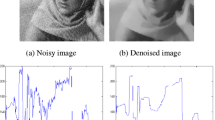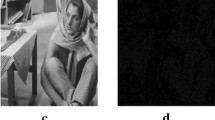Abstract
A total variation filter has the characteristic of edge protection and has been widely used in image denoising for many years. In this study, our aim was to eliminate the staircase effect generated by the total variation model effectively, while also retaining the edge details. Therefore, we propose a weighted hybrid order total variation model which uses the determinant and trace of the structural tensor to control the smoothness. We used the split Bregman iterative algorithm to numerically solve the corresponding discrete problems. A coherent enhanced diffusion filter was used for preprocessing in each iteration; then, the proposed diffusion function was used for denoising. Numerical experiments show that the model has excellent denoising and edge protection performance.








Similar content being viewed by others
References
Adam T, Paramesran R (2019) Image denoising using combined higher order non-convex total variation with overlapping group sparsity. Multidi Syst Sign Process 30(1):503–527. https://doi.org/10.1007/s11045-018-0567-3https://doi.org/10.1007/s11045-018-0567-3
Chamorro-Servent J, Abascal JF, Aguirre J, Arridge SR, Correia TM, Ripoll J, et al. (2013) Use of split bregman denoising for iterative reconstruction in fluorescence diffuse optical tomography. J Biomed Opt 18(7):076016. https://doi.org/10.1117/1.JBO.18.7.076016
Chen Y, Wunderli T (2002) Adaptive total variation for image restoration in bv space. J Math Anal Appl 272(1):117–137. https://doi.org/10.1016/S0022-247X(02)00141-5
Chen Y, Zhang X (2010) High-speed architecture for image reconstruction based on compressive sensing. IEEE Int Conf Acoust Speech Signal Process:1574–1577. https://doi.org/10.1109/ICASSP.2010.5495528https://doi.org/10.1109/ICASSP.2010.5495528
Chen Q, Montesinos P, Quan S, Heng P-A, Xia D (2010) Adaptive total variation denoising based on difference curvature. Image Vis Comput 28 (3):298–306. https://doi.org/10.1016/j.imavis.2009.04.012
Dang N, Le TT, Hien NN, Prasath S (2020) Adaptive total variation l1 regularization for salt and pepper image denoising. Optik 208:163677. https://doi.org/10.1016/j.ijleo.2019.163677
Goldstein T, Osher S (2009) The Split Bregman Method for L1-Regularized Problems. SIAM J Imaging Sci 2(2):323C343. https://doi.org/10.1137/080725891
Gui Z, Wang N, Chen Y, Yao L, Jia L (2019) Image smoothing via an adaptive fourth-order partial differential equation model. Jo Eng 11:8198–8206. https://doi.org/10.1049/joe.2018.5443
Jinchao F, Chenghu Q, Kebin J et al (2012) Total variation regularization for bioluminescence tomography with the split bregman method. Appl Opt 51(19):4501-4512. https://doi.org/10.1364/AO.51.004501
Kamalaveni V, Veni S, Narayanankutty KA (2017) Improved self-snake based anisotropic diffusion model for edge preserving image denoising using structure tensor. Multimed Tools Appl 76:18815C18846. https://doi.org/10.1007/s11042-016-4341-y
Li X, Huang TZ, Zhao XL, Ji TY, Deng LJ (2020) Adaptive total variation and second-order total variation-based model for low-rank tensor completion. Numer Algorithm 86:1C24. https://doi.org/10.1007/s11075-020-00876-yhttps://doi.org/10.1007/s11075-020-00876-y
Liu X, Huang L (2010) Split bregman iteration algorithm for total bounded variation regularization based image deblurring. J Math Anal Appl 372 (2):486–495. https://doi.org/10.1016/j.jmaa.2010.07.013
Liu X (2015) Efficient algorithms for hybrid regularizers based image denoising and deblurring. Comput Math Appl 69(7):0898–1221/. https://doi.org/10.1016/j.camwa.2015.02.011
Lysaker M, Lundervold A, Tai X-C (2003) Noise removal using fourth-order partial differential equation with applications to medical magnetic resonance images in space and time[J]. IEEE Trans Image Process 12(12):1579–1590. https://doi.org/10.1109/TIP.2003.819229
Papafitsoros K, Schonlieb CB (2014) A combined first and second order variational approach for image reconstruction. J Math Imaging Vis 48:308C338. https://doi.org/10.1007/s10851-013-0445-4
Phan TDK (2020) A weighted total variation based image denoising model using mean curvature. Optik - Int J Light Electron Opt 217:164940. https://doi.org/10.1016/j.ijleo.2020.164940
Rudin LI, Osher S, Fatemi E (1992) Nonlinear total variation based noise removal algorithms. Physica D Nonlinear Phenom 60(1-4):259–268. https://doi.org/10.1016/0167-2789(92)90242-F
Setzer S (2011) Operator splittings, bregman methods and frame shrinkage inimage processing. Int J Comput Vis 92(3):265–280. https://doi.org/10.1007/s11263-010-0357-3
Steidl G (2015) Combined first and second order variational approaches for image processing. Jahresbericht Deutschen Math-Vereinigung 117(2):133–160. https://doi.org/10.1365/s13291-015-0113-2
Wang S, Huang TZ, Zhao XL, Mei JJ, Huang J (2018) Speckle noise removal in ultrasound images by first- and second-order total variation. Numer Algorithm 78:513C533. https://doi.org/10.1007/s11075-017-0386-xhttps://doi.org/10.1007/s11075-017-0386-x
Weickert J (1999) Coherence-enhancing diffusion filtering. Int J Comput Vis 31(2):111–127. https://doi.org/10.1023/A:1008009714131
Wang Y, Wang Y (2019) Anisotropic diffusion filtering method with weighted directional structure tensor. Biomed Signal Process Control 53:101590.1-101590.8. https://doi.org/10.1016/j.bspc.2019.101590
Yang X, Guo B, Xiao Z, Wei L (2018) Improved structure tensor for fine-grained texture inpainting. Signal Process Image Commun 73:84–95. https://doi.org/10.1016/j.image.2018.02.006
Zhang X, Ye W (2019) An adaptive second-order partial differential equation based on tv equation and p-laplacian equation for image denoising. Multimed Tools Appl 78(13):18095–18112. https://doi.org/10.1007/s11042-019-7170-yhttps://doi.org/10.1007/s11042-019-7170-y
Acknowledgements
This work is supported by Major Special Science and Technology Project of Anhui Province (No .201903a06020006) and Key Project of Education Natural Science Research of Anhui Province of China (No: KJ2017A353).
Author information
Authors and Affiliations
Corresponding author
Ethics declarations
Conflict of Interests
The authors declare that there is no conflict of interests regarding the publication of this paper.
Additional information
Publisher’s note
Springer Nature remains neutral with regard to jurisdictional claims in published maps and institutional affiliations.
Rights and permissions
About this article
Cite this article
Liu, K., Xu, W., Wu, H. et al. Weighted hybrid order total variation model using structure tensor for image denoising. Multimed Tools Appl 82, 927–943 (2023). https://doi.org/10.1007/s11042-022-12393-2
Received:
Revised:
Accepted:
Published:
Issue Date:
DOI: https://doi.org/10.1007/s11042-022-12393-2




